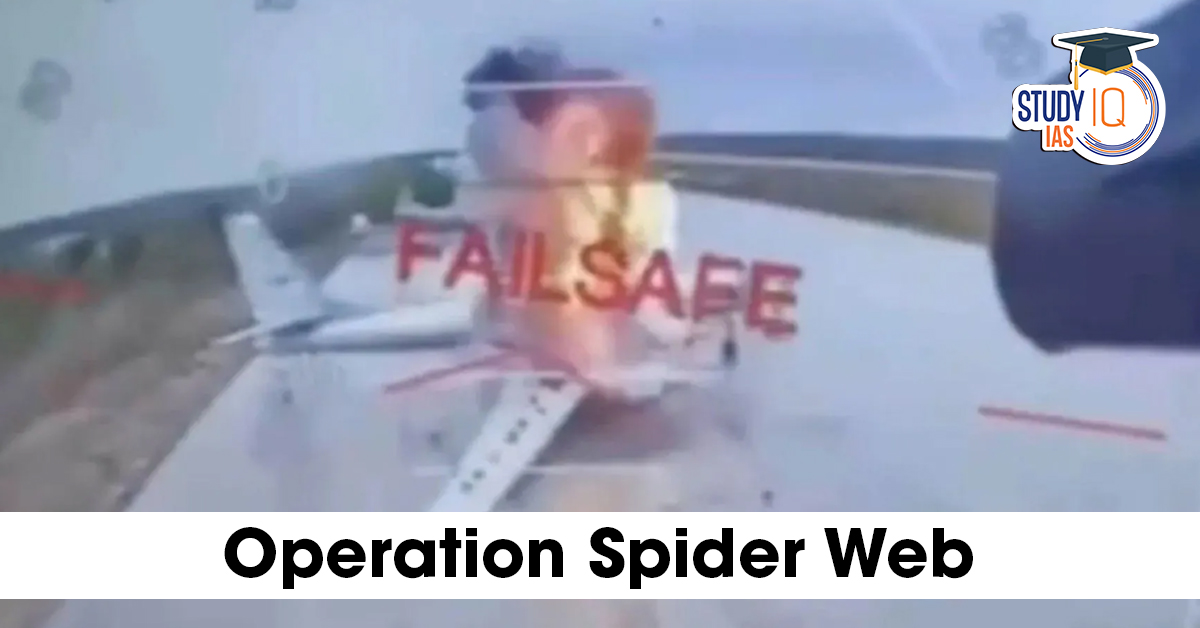Table of Contents
Operation Spider Web
Operation Spider Web is the most ambitious and technologically sophisticated Ukrainian military operation during the Russia-Ukraine war. Commenced on June 1, 2025, this large-scale drone attack was carried out deep within Russian territory, targeting some strategic airbases and destroying critical infrastructure, including long-range bombers. The Operation Spider Web is a landmark in modern-day warfare and one that underscores the potential of unmanned vehicles in achieving military objectives without human intervention.
| About Operation Spider Web | |
| Name | It was codenamed “Operation Spider Web” (Ukrainian: Операція «Павутина», romanized: Operatsija “Pavutyna”) by the Security Service of Ukraine (SBU). |
| Date | June 1, 2025 (Sunday) |
| Execution | It was reportedly planned for more than 18 months and personally overseen by Ukrainian President Volodymyr Zelenskyy. It was an “extremely complex” logistical operation. |
| Methodology | Ukrainian security sources report that drones, namely First-Person View (FPV) drones loaded with explosives, were secretly smuggled into Russia. They were concealed inside mobile wooden cabins carried by trucks. When the time was ripe, the roofs of the cabins were remotely opened, and the drones took off, attacking nearby airbases. The Ukrainian agents concerned were said to have been evacuated before the attacks. |
| Scale | Ukraine claimed to have used 117 drones in the coordinated strikes. |
Objectives of Operation Spider Web
The major objective of Operation Spider Web was to:
- Remove Russia’s strategic airstrike threat capability by destroying aircraft employed in long-range bombing missions
- Undercut Russian morale and air supremacy through precise attacks on high-value targets
- Indicate Ukraine’s capability to strike deep into Russian territory, marking a change in tactical policy and deterrence.
Targets and Locations targeted under Operation Spider Web
The operation struck several Russian military airbases deep inside Russian territory, covering a number of time zones. Major airbases hit, according to reports, are:
- Olenya Airbase (Murmansk Oblast, Russian Arctic) – around 1,900 km from Ukraine.
- Belaya Airbase (Irkutsk Oblast, Siberia) – more than 4,000 km from Ukraine.
- Dyagilevo Airbase (Ryazan Oblast)
- Ivanovo Severny Airbase (Ivanovo Oblast)
- Voskresensk Airbase (Moscow Oblast)
- The targets were strategic bombers like Tu-95, Tu-22M3, and Tu-160, as well as A-50 AWACS aircraft. These are essential assets for Russia’s long-range missile strikes on Ukraine.
Carrying out the Operation
From Ukrainian military sources and global defense experts:
- Ukraine launched 117 First-Person View (FPV) drones, discreetly packed into trucks that were launched near the Russian border.
- The drones struck five large Russian airfields, including those based in Murmansk, Saratov, and Siberia.
- The drones were said to be remotely guided through GPS jammers and artificial intelligence-based navigation systems, which enabled deep penetration of Russian airspace.
Damage Caused
The mission resulted in:
- Destroying or crippling more than 40 Russian warplanes, including strategic bombers like Tu-95s and Tu-22s.
- Approximately $7 billion in economic and military losses for Russia.
- Short-term disruption of Russia’s capability to make long-range bombing raids on Ukrainian cities and infrastructure.
- This mission is the deepest and most successful Ukrainian attack on Russian territory since the start of the conflict in 2022.
Global Reactions
- The Western countries, led by the U.S. and UK, recognized the success of Ukraine’s drone warfare while calling for restraint to avoid more escalation.
- Russia denounced the attack as a terrorist act and threatened retaliation, later launching drone and missile attacks on several Ukrainian cities.
Significance and Future Implications
Operation Spider Web reflects a trend in modern warfare, where:
- Unmanned systems and asymmetric tactics are capable of disabling even highly defended strategic targets.
- It shows Ukraine’s increasing technological capacity and indigenous military capabilities.
- The operation can shape the way the world’s great military powers use AI and drones in their conventional combat tactics.
- As the war stretches on, Operation Spider Web is a defiant declaration of Ukraine’s determination, ingenuity, and changing strategic doctrine.
- Deep Strike Capability: “Operation Spider Web” demonstrated Ukraine’s greatly improved ability to perform deep-strike operations deep behind the front lines, reaching crucial Russian strategic targets.
- Deterrence: The operation is a warning that none of Russia is not completely secure from Ukrainian retribution, possibly compelling Russia to scatter its strategic aviation and spend more on air defence.
- Effect on Peace Talks: The timing of the attack, mere hours before a fresh round of direct peace negotiations between Russia and Ukraine in Istanbul (on June 2, 2025), indicates an ambition to strengthen Ukraine’s bargaining position.
- Evolution of Drone Warfare: The sophisticated methodology, involving covert infiltration and remote launch from within Russian territory, marks a significant evolution in drone warfare tactics, potentially influencing future military doctrines globally.
- Psychological Impact: The attacks likely have a significant psychological impact within Russia, demonstrating Ukraine’s reach and the vulnerability of seemingly secure strategic assets.


 National Project for Strengthening Disas...
National Project for Strengthening Disas...
 CAG Report on Pradhan Mantri Kaushal Vik...
CAG Report on Pradhan Mantri Kaushal Vik...
 NITI Aayog Report on Public R&D Inst...
NITI Aayog Report on Public R&D Inst...

























